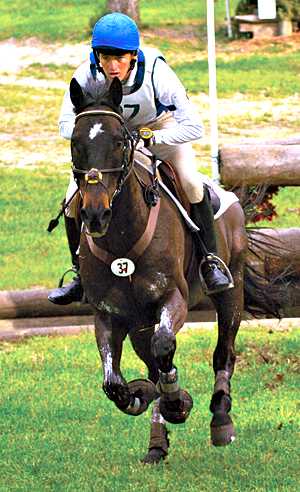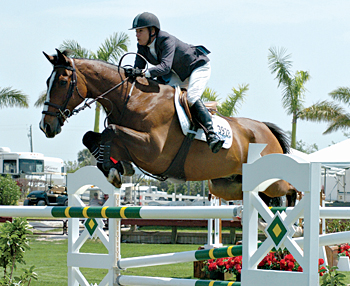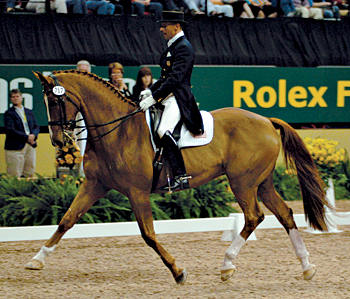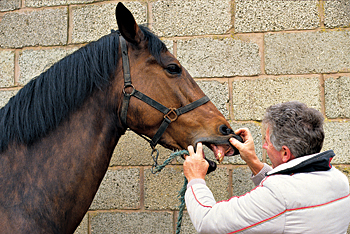Competition veterans may require more attention, but it’s well worth the effort for those owners and riders who cherish a long-lasting partnership or a schoolmaster.
They gently teach beginners, often save riders from missed distances and carefully carry many youngsters to their first ribbons. With advances in care and technology, today’s horses are healthily competing at an older age—even into their late teens and 20s—many at top levels of competition.
There isn’t a magic formula to prevent your horse from aging, but understanding important factors can greatly improve the quality of life and length of career.
 About 20 percent of the horse population in the United States is over age 15. Consider that one year of a horse’s life is roughly equivalent to three years of a human’s life, and it’s understandable that treating the older horse is comparable to treating a 45-year-old person. They’re still contenders in the ring but may require extra attention.
About 20 percent of the horse population in the United States is over age 15. Consider that one year of a horse’s life is roughly equivalent to three years of a human’s life, and it’s understandable that treating the older horse is comparable to treating a 45-year-old person. They’re still contenders in the ring but may require extra attention.
“One of the great things about older horses is that they want to be there. They want to compete, and they love their sport,” said three-day eventer Will Faudree.
Proper maintenance and care can greatly reduce problems associated with an older horse. Understanding
fitness, updating veterinary care and maintaining a proper diet are the general guidelines for keeping a horse feeling fresh and fit for the longest time possible.
“There’s nothing unique to the older horse necessarily, but there are many choices today for the problems that arise in their respective areas,” said John Nolan DVM of Piedmont Equine Practice, The Plains, Va.
The routine care of an older horse doesn’t necessarily require a drastic change, but consulting with a veterinarian to improve diet and exercise will lead to rewarding results. Identifying the changing needs and practicing preventative measures greatly reduces the need for costly medications and procedures.
“There may be injuries that are more prevalent to some in certain disciplines, but overall, their anatomy is the same, no matter what their athletic sport. There are some older horses that are amazingly sound and some young horses that are amazingly unsound,” Nolan said.
Fitness First
As a horse ages, muscles become smaller and are replaced by fat, which affects the tendons and ligaments. Though many owners believe decreased exercise is better for the older horse, a structured fitness program will keep the joints and surrounding muscles healthier for continued use. Even under moderate work, exercise stimulates the cells to strengthen the tendons and maintains healthy joint cartilage. Older horses don’t require as much schooling, but consistent work appropriate for competition maintains soundness and condition.
Faudree, who competes at the CCI**** level with 19-year-old Antigua, recognizes fitness as a key component to his horse’s well being. “A lot depends on the horse and the desire to compete. Antigua’s always been a very fit horse, and at the end of the day he’s a race horse,” Faudree said of his Thoroughbred gelding.
Faudree, 27, bases his fitness training from the two years he spent working at Phillip Dutton’s True Prospect Farm, West Grove, Pa. “Phillip is an amazing competitor and a sportsman. I learned so much about fitness from working with him, especially how to utilize shorter, faster sprints,” Faudree noted.
Due to the physical demands in three-day eventing, riders such as Faudree take important steps to build their horses’ heart and lungpower. Antigua benefits from hacking, canter sets and short sprints to build up his wind power, and like any human athlete, Faudree tapers down his last gallops before a competition.
“Fitness is very important for our sport, and building up their wind base is equally as important,” Faudree explained. “They need to know how to breathe, and they need to learn to breathe when they’re going fast.”
Even with their seven-year partnership, Faudree continues to be amazed by Antigua’s athletic ability. “He never pulls, but he absolutely loves to run and jump. I think the horse’s fitness is at least 50 percent of keeping them in the game,” he said.
Like Faudree, show jumper Laura Kraut relies on constant exercise to keep her 17-year-old Anthem in the show ring. Kraut has competed with the Dutch Warmblood gelding since he was 8, including winning the $100,000 Budweiser AGA Championship (Fla.) in 2004 and the $500,000 Charlotte Jumper Classic (N.C.) in 2008.

“We’ve always kept him working and he’s always being ridden, on trails, on the flat, the walker or in the ring,” she said. “We keep him very fit. He’s always moving around or staying busy.”
Along with stronger muscles and increased lungpower, horses on a constant exercise routine benefit from enhanced blood flow to the synovial membrane, the tissue that makes the nourishing joint fluid. Exercise helps deliver nutrient-rich blood to the synovial membrane and removes harmful wastes and enzymes, helping the older horse feel fresh.
Even with Anthem’s older age, Kraut sees little change in his energy level. “Obviously, in some ways he’s become better, but he still wants to play and buck and overall he feels very good,” she said.
Olympic dressage rider Steffen Peters agreed with Faudree and Kraut on the emphasis of training to prevent health issues. Peters, who showed the teenaged Floriano internationally for several years, said, “there’s no substitute for good training. Even modern medicine can’t completely make up for it.”
ADVERTISEMENT
Peters continually monitored Floriano’s respiratory rates and, like Faudree, eased his horse’s exertions before major competitions. Twice-daily cardio workouts included galloping in a large arena, with light practice on movements followed by Peters assessing Floriano’s heart rate.
“You can tell very quickly [how they’re progressing] by watching their heart rates. We would practice this up to 10 days before a competition and then go into easy mode, like a human. It made him very supple when it was time to show,” he said.
Different Choices
Along with fitness, preventative veterinary care can keep the older horse active. Proper shoeing and dental care are important, but owners need to have their veterinarians carefully examine a horse’s cardiovascular and endocrine systems.
“Some of the most debilitating diseases occur in these systems, and it can be a real problem that can lead to something even more catastrophic,” Nolan said.
He recommended a cardiovascular evaluation, including an EKG exam, to rule out risk factors. Vascular problems in the heart should be addressed, as horses who gallop can suffer possible aneurysms in the aorta.
Because many symptoms go undetected with heart and breathing patterns, regular veterinarian checks are an absolute must for an older horse. As a horse ages, lung capacity decreases, but corticosteroids and antihistamines are frequently prescribed. Vaccination schedules need to be kept up to date due to weakened immune systems, including additional protection against strangles, influenza and rhinopneumonitis, the latter two that affect the respiratory system.
“I think the biggest thing in campaigning is to spare no expense with modern veterinary medicine. Everything we can do is done to that extent with Antigua,” Faudree said.
Even with current medical care, he still practices simple procedures such as icing and poulticing every time his horse gallops.
Nolan also routinely checks for Cushing’s disease, an endocrine system disorder that results from a nonmalignant tumor in the pituitary gland. High levels of corticosteroids are produced in the horse’s system, leading to weakened muscles due the lack of glucose in the cells needed.
 Older horse owners should also have veterinarians examine the basic musculoskeletal system multiple times a year as well, as lameness and chiropractic evaluations will address issues before they become substantial problems. Arthritic joints and bone inflammation will become more apparent as a horse ages, but in addition to injections, drugs such as Tildren can ease soreness.
Older horse owners should also have veterinarians examine the basic musculoskeletal system multiple times a year as well, as lameness and chiropractic evaluations will address issues before they become substantial problems. Arthritic joints and bone inflammation will become more apparent as a horse ages, but in addition to injections, drugs such as Tildren can ease soreness.
“Like humans, horses can start to have changes in their bone mass,” Nolan noted.
“We have so many therapies today for older horses, I feel it’s a disservice if I don’t offer my patients everything possible,” he continued.
Almost every horse who continually competes will benefit from injection therapy, especially hock injections. Owners may also consider shockwave therapy and regular sessions with a chiropractor for back soreness.
“We’ve been having the same routine vet exams with Anthem, and our biggest concern is just keeping up with everything in his system,” Kraut said. “We also stay very on top of his shoeing because he has bigger, flatter feet.”
Peters and his veterinarians continually monitored for possible signs of wear in Floriano’s joints, though he rarely felt the need for injection therapy. “I think it can be helpful, and for some horses it can prove to be very effective,” Peters said.
Dental care is equally as important to the older horse. Equine dentists should make routine visits, and floating should be performed twice yearly. Without proper care, teeth can become flat and ineffective, making it nearly impossible for horses to chew and digest food. Signs of dental problems can be found in horses dropping food, weight loss, and a loss of appetite for dry feeds.
Proper veterinary care will cost more with an older horse, but riders such as Faudree find it necessary. “The younger horses don’t need as much, and yes, it can get expensive. But you can’t afford to give it and you can’t afford not to. It’s really a requirement to keep a horse going.”
Nutrition Matters
ADVERTISEMENT
Aging horses suffer from inefficient digestive systems and require a diet tapered to their needs. Nutritional
supplements have become almost entirely commonplace for active older horses today, ranging from digestive to joint needs. Healthy cells are pertinent for repairing damage from the stresses of competition, and a well-rounded diet provides nutrients for proper functions.
Adequate protein intake is important for older horses, due to the possibility of muscle loss, poor-quality hooves and respiratory infections. Feed for the older horse should include a higher amount of protein, usually around 12 percent, and fat and fiber. Higher percentages of protein provide amino acids for better muscular and tissue growth.
Riders such as Faudree rely on feed aimed for senior horses, which provides important vitamins and minerals that cannot be easily absorbed through regular feed. “I also use Adequan for joint maintenance too,” he said.
Kraut continually uses supplements for Anthem’s joints and muscles, as well as Succeed, a formula to support digestive health during the stresses of training and competition. UlcerGard (omeprazole), another favorite among international professionals, prevents gastric ulcers that can develop from the stresses of travel.
For Floriano, nutrition was one of Peters’ biggest concerns. “He was always a nervous horse and a very social horse, so we had to be careful. We treated him on Succeed,” he said.
Peters, who is based in San Diego, Calif., found trips to Europe especially challenging.

“I don’t believe in too many supplements, but we used GastroGard for times when we would fly to places such as Amsterdam,” he said.
Feeding schedules need not be sophisticated but must be monitored to observe any weight loss associated with aging horses. Grain should be followed with hay in an easily digestible form, usually one that has minimal stems. Grass is a better choice due to the higher nutrition content and because it’s easier to chew.
“We struggled a bit with Floriano’s weight, since he could be a nervous horse,” Peters said. “It’s not about too many fancy things, it’s about the quality of the food. We made sure to provide about five hay feedings a day, and there were plenty of hours with food in front of him.”
Owners should experiment with different senior feeds to find out which one suits their horse best and maintains a healthy weight. “Nutrition is one of the more challenging aspects in the older horse and in trying to get their body conditioned. But sometimes that’s because there’s an underlying problem. These things tie together, and they should be checked during exams,” Nolan said.
Looking Ahead
Even though they require extra care and higher costs, older horses provide many benefits for owners, riders and caretakers. “They’re doing the same sport they’ve done in the past, some at lower levels, and everybody associated with them knows them very well. It makes my job much easier,” Nolan said.
For Kraut, she enjoys the partnership with an older mount. “Anthem’s become more predictable, and in some ways he’s become better. I see myself doing the same thing with him six months from now, a year from now. I’ll keep him fit and ready to go until the day he indicates there’s no more.”
Many older horses enjoy the competition as much, if not more, than their riders. As Antigua has aged, Faudree notices his fitness levels have stayed the same, although the gelding has developed noticeable quirks.
“He’s actually become spookier. He’s always been that way when he gets fit and it becomes a little magnified,” Faudree added with a laugh. “He definitely anticipates the crowd, and it can affect him. I have to time my warm-ups accordingly, especially if the crowd is loud or it’s at the end of the day.”
Older horses can remain world-class competitors, and many go on to teach junior and amateur riders
coming up through the ranks. Former grand prix show jumpers can be found in the equitation ring, stakes-winning Thoroughbreds in the hunt field, and three-day event horses as suitable mounts for novice adult riders.
Riders agree the extra effort is worth the invaluable benefits of competing with an older horse. “Floriano was one of those horses that had a naturally serious go button, and I never really noticed much of a change in him,” Peters remembered.
Faudree believes older horses will always remain at all levels of competition, saying, “It’s a great tribute that older horses can go out and do what the younger ones do. They love the sport, they love to compete, and the worse thing you can do is take that away from them. They’re the warriors out there.”
Beth Johnson






